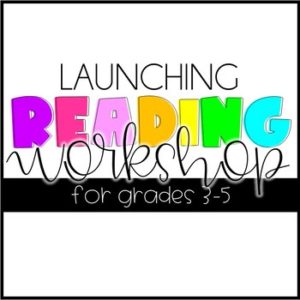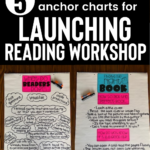Reading workshop supports readers by allowing them choice. Teaching a mini-lesson with a focused skill, reading mentor text, creating anchor charts as a group, allowing independent practice, and providing direct instruction at their instructional reading levels will help improve students’ fluency, comprehension, and vocabulary but also foster a love of reading and learning in your students.

Why Should You “Launch” Reading Workshop?
Launching reading workshop refers to the first weeks of reading when you create a sense of community and build classroom routines. Modeling and setting high expectations in the first weeks of reading workshop is so important in creating a successful workshop. The goals of the launching reading workshop time period are to create a community of readers, encourage genuine discussions about reading, learn individual student’s strengths and needs, set expectations for student learning, create an environment that keeps students highly engaged, and encourages students to take responsibility for their learning.
Allowing time to learn each aspect of the workshop model through practicing good reading habits and strategies allows students to participate in and soak up the new learning experiences. You are creating lifelong learners and readers and taking the time to launch your workshop is creating habits that will last well beyond your 180 days together. You are developing good habits and filling them with the knowledge that they need to be successful.

Routines during reading workshop are so very important. When beginning your reading workshop, modeling expectations is key to ensure that your workshop will run smoothly. When you think about the beginning of the year and teaching routines and procedures, it takes a while to model and teach those procedures, but soon it becomes a habit and things just happen on their own. The same goes for reading workshop!
Model, model, model your expectations, slowly giving students independence, and then right before your eyes your reading workshop has truly turned into a workshop, producing little readers! When your students have a consistent routine of reading each day; their reading, and their love for reading, will flourish.
Using Anchor Charts
An anchor chart is created during the mini-lesson and is a part of the instruction. It is a way to record the strategies and skills you are working on. An anchor chart helps make your thinking visible to your students and can remain displayed for students as a reference. Students can copy the anchor charts into their reader’s notebooks to refer back to as well. While an anchor chart can be prepared before a lesson, students should actively participate in creating the anchor chart with you.
During the mini-lesson, the whole group will sit together, ideally on a carpet or small meeting area. The mini-lesson introduces the focus skill for the day. This time is meant for whole group instruction where the teacher will lead as students listen.
This time is used to read mentor text (if applicable) and create an anchor chart. Anchor charts should be made with students sharing their ideas and thinking. They are a great way to keep the skill visible as students move to work independently. You may have a mini-anchor chart for students to keep in their reader’s notebooks or just have students copy the anchor chart. The end of the mini-lesson should encourage students to try the focus skill as they work independently.

5 Favorite Anchor Charts to Launch Reading Workshop
1. Independent Reading
Independent reading is a very important component of reading workshop and establishing expectations for independent reading time while you launch reading workshop is so important!
Create an anchor chart with your students with expectations for independent reading time.
2. Student's Job & Teacher's Job
Setting expectations is truly the reason why launching reading workshop works. When students know what is expected of them, they are able to stay focused and on task, allowing you time to meet with groups, hold conferences, and most importantly, do these things uninterrupted.
When you lay out the expectations for students, you can also discuss what YOU will be doing during reading workshop. And when students know their job, they are aware of their expectations. But knowing your job allows them to see the importance of their own jobs during the workshop.
You can have students write down on sticky notes a job that THEY will do and a job that YOU will do and create an anchor chart.
3. What Do Readers Do?
Reading workshop helps students develop as lifelong readers. They have time to read and learn strategies to use during that time. As you launch reading workshop, you can help students understand that independent reading time is much more than finding a spot and reading the whole time. As we read, we use strategies to grow as readers. We are constantly thinking, stopping to write, and thinking about the text even deeper. We learn to love reading by using the strategies that we are taught, choosing books that we love, and asking for help when needed.
Create an anchor chart with students to discuss reading strategies that readers use as they read. Being an active reader makes reading more meaningful while helping students develop as readers.
4. Finding the Right Book
Finding a good book that is just right will make reading more interesting and enjoyable for your students! And when they are interested in and enjoying the book that they are reading, that allows you time to meet in small groups and conference with students uninterrupted (which is a reoccurring theme of our workshop!). And taking time to help students learn to pick books as you are launching reading workshop will save you time later.
Having a variety of books to choose from or using library books are great options to help students choose from a wide variety of books.
It is also important to teach students that it is ok to abandon a book *sometimes*! You may not always like a book and if you’ve given it a fair chance (more than just a page or two), then it is ok to put it away. We may not finish every book that we start and learning when to move on gives students a choice, which is so important in developing a love for reading.
5. Setting Reading Goals
As readers our students are always striving to become better and setting goals helps keep them focused and working to become stronger, more active readers. Your students should set goals throughout the year and conference to talk about meeting those goals.
Introducing reading goals is important during launching reading workshop because setting goals gives students a purpose for their reading. They now understand the expectations of reading workshop and setting goals gives them a focus too.
You can create an anchor chart with examples of behavioral and strategic goals and give an example of each type of goal. Give students each two sticky notes. Have them write down two goals that they will work on, one behavioral goal and one strategic goal. Talk about how they can meet one goal while still working on the other!
As students start to read independently, encourage them to notice as they are reading if they are working on their goals and how can they actively read to do so.
Launching reading workshop can take time and effort, but once your routines are in place, you will be in awe of how your students work independently, grow as readers, and develop their skills. It is truly a magical thing!
You can grab a free calendar for the first 10 days of reading workshop below!
Want more reading workshop?
Check out these reading workshop posts.
You can shop all of the anchor charts and materials for launching reading workshop here:
Happy Reading!









